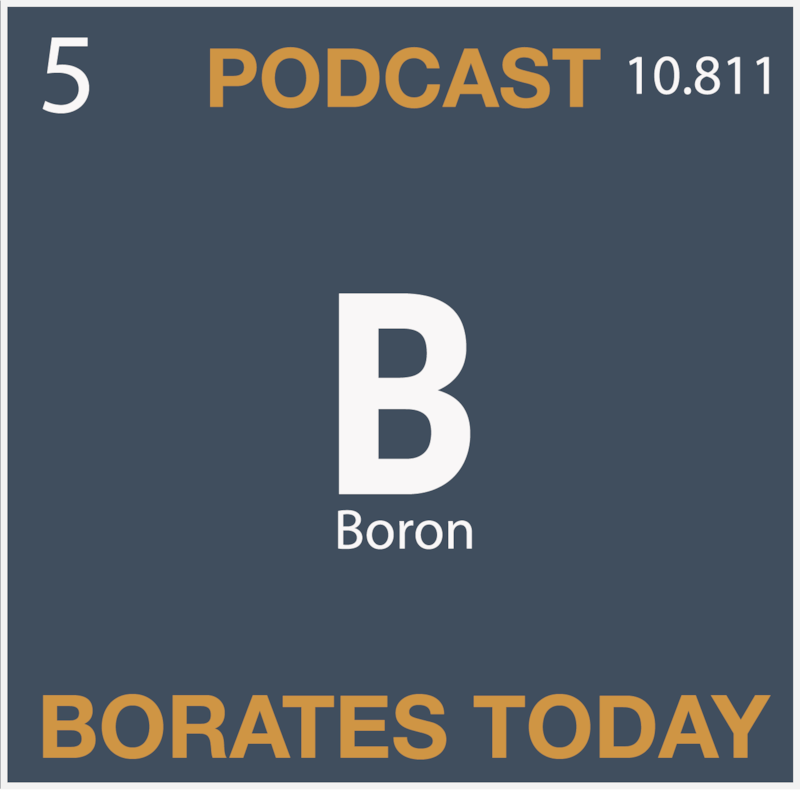
Shownotes
In today's podcast, we're going to look at decarbonization opportunities in the mining industry and how mining can help achieve net zero emissions.
The mining sector has a key role in the transition to net zero emissions. Although it currently accounts for less than 7% of global emissions it is one of the most energy-intensive industries and its products are used in a wide range of other sectors.
Reducing emissions from mining is essential if we are to meet our climate change goals.
Transcripts
Welcome back to the Borates Today podcast.
Brendan:Each week we cover a topic that is relevant to the industry and timely.
Brendan:We cover the latest industry news.
Brendan:Who are the key players in the sector?
Brendan:What are the latest trends, driving demand and supply for boron.
Brendan:What is the science behind boron and who's doing valuable research into
Brendan:new boron applications and benefits?
Brendan:We look at how boron helps in advanced energy, in food security,
Brendan:and in providing nutrition.
Brendan:So don't forget to check out boron applications and benefits
Brendan:on our website borates.today.
Brendan:In today's podcast, we're going to look at decarbonization opportunities
Brendan:in the mining industry and how mining can help achieve net zero emissions.
Brendan:The mining sector has a key role in the transition to net zero emissions.
Brendan:Although it currently accounts for less than 7% of global emissions it
Brendan:is one of the most energy intensive industries and its products are used
Brendan:in a wide range of other sectors.
Brendan:Reducing emissions from mining is essential if we are to
Brendan:meet our climate change goals.
Brendan:How Mining Can Help Achieve Net Zero Emissions
Brendan:A new report by the Bank of America has warned that a lack of action
Brendan:on metal supply could hamper the global transition to net zero.
Brendan:It states that many critical metals are at risk of being in short supply as demand
Brendan:for them increases in the coming years.
Brendan:While markets have focused on copper and nickel, the report recognizes 27
Brendan:metals, including aluminum, chromium, cobalt, molybdenum, manganese,
Brendan:steel, silicon, boron and others.
Brendan:These raw materials are critical components in various
Brendan:applications from renewable energy production to electric vehicles.
Brendan:As the world looks to achieve net zero goals, many necessary technologies
Brendan:have already been developed.
Brendan:However, many minerals and metals will be needed to scale up these technologies,
Brendan:far more than currently available.
Brendan:For example, analysts estimate that between 2020 and 2030 demand
Brendan:for nickel could rise by 40%.
Brendan:Demand for lithium could also go up by 38% during the same period.
Brendan:This supply-demand imbalance could hamper efforts to decarbonize the economy.
Brendan:Until mining capacity increases and appropriate mining methods
Brendan:for, for lowering carbon emissions.
Brendan:The bank of America goes on to say that we will need to significantly
Brendan:increase our investment in mining and raw materials to meet the climate goals.
Brendan:The present level of metals required to reduce carbon emissions is not sufficient.
Brendan:According to the analyst's raw material, industry's are already tight and
Brendan:will tighten even more as demand for reduced carbon technologies develops.
Brendan:And based on recent resource endowments and industry balances., It's unlikely
Brendan:that we'll be able to meet the 1.5 degrees centigrade global warming goal by 2050.
Brendan:Let's Look at Mining Strategies for Decarbonization.
Brendan:As the world looks to decarbonize to avert the worst effects of
Brendan:climate change, the mining industry will need to play its part.
Brendan:There are many different strategies that minds can adopt to reduce their emissions
Brendan:and to help achieve global climate goals.
Brendan:One such strategy is to switch to cleaner energy sources.
Brendan:This could mean investing in renewable energy sources like solar or wind
Brendan:power or using less energy intensive methods for extracting minerals.
Brendan:For example, some mines are now using electric vehicles
Brendan:instead of diesel ones, which can significantly reduce the emissions.
Brendan:Another strategy is to focus on reclamation and rehabilitation efforts.
Brendan:This means ensuring that a mine is properly cleaned up
Brendan:and restored after it's closed.
Brendan:This can help reduce the impact of mining on local ecosystems
Brendan:and prevent greenhouse gases from being released into the atmosphere.
Brendan:Finally, mines can also look to offset their emissions by investing in
Brendan:carbon reduction projects elsewhere.
Brendan:For example, this could involve planting trees or investing
Brendan:in clean energy technologies.
Brendan:By offsetting their emissions, mines can help make a real difference in
Brendan:the fight against climate change.
Brendan:Let's take a look at some mining companies who have set decarbonisation goals.
Brendan:Historically, being among the largest polluters in the world, mining companies
Brendan:are responsible for a significant share of global greenhouse gas emissions.
Brendan:But as public awareness of change has grown so too has pressure.
Brendan:In response, many companies are now setting ambitious
Brendan:goals for decarbonization.
Brendan:One of these is five-year advanced materials, formerly known as
Brendan:American Pacific Borates, fEAM, as it's also known, plays a leading
Brendan:role in the de-carbonization agenda through the use of Borates.
Brendan:The company is actively involved in making energy, transition and storage,
Brendan:more efficient and sustainable, and working on electrification
Brendan:and food security solutions.
Brendan:According to the CEO, these plans and efforts will eventually lead to
Brendan:green energy, and a greener planet.
Brendan:FEAM owns Fort Cady, a strategically important mineral asset in Southern
Brendan:California and is targeting to unlock substantial value
Brendan:through extraction of boric acid.
Brendan:Boric acid has many legacy applications, including glassware, fertilizers,
Brendan:ceramics, and detergents and newer, quicker growing applications, which
Brendan:meet the decarbonization goals.
Brendan:Boron is used in neodymium magnets, which power wind turbines.
Brendan:FEAM also practices sustainable mining techniques to help improve
Brendan:its relative value and minimize the environmental impacts of mining boron.
Brendan:For more information on decarbonization and the mining industry, please
Brendan:refer to the Borates Today website.
Brendan:And that's all for today.




